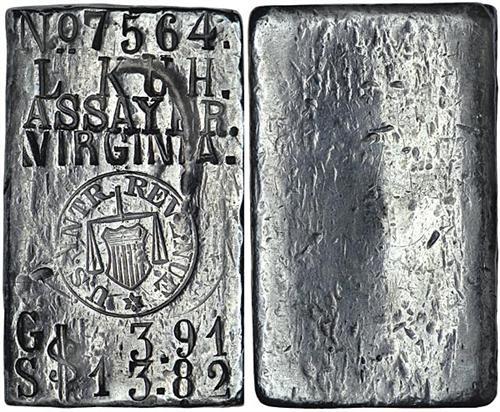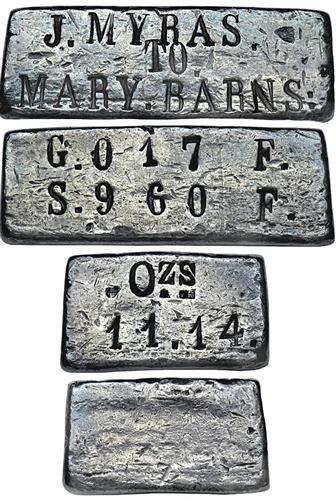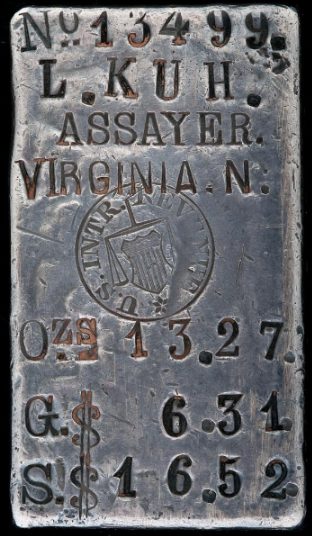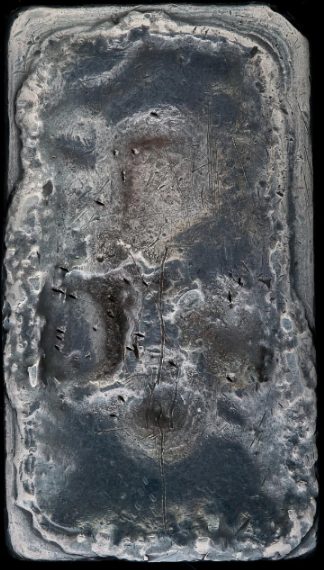1856-1860
Leopold Kuh. Resides at Green betw. Kearny and Dupont. Leopold Kuh works at the U.S. Mint. Colville’s San Francisco Directory for the Year
Commencing October 1856 Kuh, Leopold. Clerk U.S. Branch Mint. Dwells at
NE corner Green and Lafayette. Langley’s San Francisco Directory for the Year
Commencing January 1, 1858 Kuh, Leopold & Fisher Henry I. Gold refinery.
Taylor Sr. Wharf corner Green and Lafayette Place. Langley’s San Francisco Directory for the Year Commencing June 1859 Leopold Kuh. Age 43. Occupation Clerk. Birthplace Hungary. Married, three children.
1860 Eighth Federal Census, San Francisco, California, San Francisco County. Leopold Kuh at Gold Refinery corner Brannan and Harris. Dwells at NE corner Green and Lafayette. Langley’s San Francisco Directory for the Year Commencing July 1860
1861-1865
Leopold Kuh & Co. James S. Harrison and Joseph Butler Metallurgical Works. Clark between Davis and East. Dwells at 994 Mason. Langley’s San Francisco Directory for the Year Commencing September 1861 Leopold Kuh, (Late U.S. Br. Mint, San Francisco,) Assayer and Metallurgical Chemist. A Street, at the
Central Company’s Mine, Virginia City. First Directory of Nevada Territory J. Wells Kelly, San Francisco 1862. Virginia City. Leopold Kuh. Late U.S. Branch Mint, San Francisco Assayer and Metallurgical Chemist. A
Street Near the Ophir Mine. Kelly’s Second Directory of Nevada Territory, 1863 Virginia City. Leopold Kuh of the Branch Mint in San Francisco has an assay office on A Street, near the Ophir Mine, and the unbounded public
confidence and his vast professional experience, gives him a leading position among the assayists of the Pacific Coast. Mercantile Guide and Directory for Virginia City, Gold Hill, Silver City and American City, 1864-
1865.
Leopold Kuh, Assayer and Metallurgical Chemist. Office On Taylor Street, southwest cor. of D. street, Virginia. Established in 1861. Bullion Melted, Assayed, And returns thereof made in stamped Bars or Coin. The correctness of his computations is proved in the same way as done by him during a number of years in the U.S. Mine, San Francisco. All kinds of Ores and Minerals tested, assayed and analyzed. Refers to Public Opinion.
Gold Hill Daily News, 1865
1868
A Rare Chance, All My Assaying Apparatus, Utensils, Materials, Etc. Also, a very comfortable House and Lot, Situated on Sutton Av. corner of Stewart Street, For Sale at a Bargain. Leopold Kuh, corner Taylor and D streets, Virginia, Nevada. Daily Safeguard, November 2, 1868 (Virginia City) Leopold Kuh assayer and metallurgical Chemist. 611 Commercial. Dwells at 1906 Powell Street. Leopold Kuh (Formerly of the U.S. Branch Mint San Francisco) Assayer and Metallurgical Chemist No. 611 Commercial Street Opposite U.S. Branch Mint San Francisco, Cal. Langley’s San Francisco Directory for the Year Commencing December 1869
1870-1886
Leopold Kuh. Age 54. Occupation Assayer. Personal Estate $1,000. Birthplace Hungary. 1870 Ninth Federal Census, San Francisco, California, San Francisco County. Kuh. In this city, March 21, Leopold Kuh, a native of Hungary. Age 70 years, 5 months. Alta California, March 22, 1886
11.14 oz Leopold Kuh, Assayer. Virginia City, Nevada Territory. Silver & gold assay ingot no. 7564.


Overall appearance of Very Fine. A solid and hefty presentation ingot that looks, in miniature, much like one of its larger, commercial brother ingots must have. Medium silver gray color. Some flaws and roughness on all sides, fairly serious flaw on face. All sides polished in one degree or another, the cooling fissure on the back smoothed for the purpose. The bar’s stampings were laid out so they would all be right side up and legible if the bar was set on a table with its face up. No corners clipped. Extremely rare: the cataloguer can recall just this and the 13.27 ounce bar shown in Mr. Ford’s circular published in Dave Bowers’ American Coin Treasures and Hoards (1997). Before Dan Owens’ work on western assayers was published Mr. Ford believed that Kuh was Chinese, probably because the name did not seem western to him.
- Face: No..7564. / L. KUH. / ASSAYER. / VIRGINIA. / OIR stamp /G.$ [vertically between this and the next] 3.91 / S.13.82. Back: blank.
- Top side: blank.
- Bottom side: Ozs.. / 11.14.
- Left side: G.017 F. / S.960 F.
- Right side: J. MYRAS / TO / MARY BARNS.
- Dimensions: 54.4 x 33.5 x 18.7 mm.
- Stated weight: 11.14 ozs.
From the John J. Ford, Jr. Collection
Provenance: Recorded on Mr. Ford’s informational card that accompanies the lot as “Nov. 1954. Obtained from the D.K. estate by N.N., 11/6/54, and traded to Franklin as part payment of the B & A strip, 11/11/54.”
[10/2007] https://auctions.stacksbowers.com/lots/view/3-AV6MX/leopold-kuh-assayer-virginia-city-nevada-territory-silver-gold-assay-ingot-no-7564 ($21,850)
13.27 oz Leopold Kuh, Assayer. Virginia City, Nevada Territory. Silver & gold assay ingot no. 13499.
Page 267, Mr. Ford’s circular published in Dave Bowers’ American Coin Treasures and Hoards (1997).
“At right, an electrum or mixed metal assay ingot, issued at famous Virginia City, Nevada, by L. Kuh, a Chinese assayer, in the heyday of the great Comstock Lode.”
See: https://archive.org/details/americancointrea1997bowe/page/266/


This ingot now resides in the collection at the Smithsonian Institution.


Obverse Text: NO. 13499. / L. KUH. / ASSAYER. / VIRGINIA. N. / OZS. 13.27 / G. $6.31 / S. $16.52
Edge Text: S. 963 F. / G. 023 F.
Date Made: ca 1870
Louis Kuh’s surname reminds us that immigrants from Central Europe played an important role in Western history and frontier numismatics. Kuh spent some time in California, but he eventually set up shop in the epicenter of the Nevada strike, Virginia City. Here he assayed silver and gold, turning some of it into mixed precious-metal bars. The circular stamp with a shield is a federal revenue mark, indicating that taxes had been paid on the metal this bar contained. This type of stamp was a wartime measure: the Union government of Abraham Lincoln needed growing revenues to defeat the Confederacy, and taxing metal (and stamping it to show that the tax had been paid) was one way of raising money. Since the law creating the system was passed in 1864, this gives us an approximate date for this object.
See: https://americanhistory.si.edu/collections/nmah_1102651
